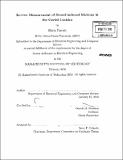In-vivo measurement of sound-induced motions in the gerbil cochlea
Author(s)
Farrahi, Shirin
DownloadFull printable version (4.769Mb)
Other Contributors
Massachusetts Institute of Technology. Dept. of Electrical Engineering and Computer Science.
Advisor
Dennis M. Freeman.
Terms of use
Metadata
Show full item recordAbstract
We developed methods to measure sound-induced motions in a live mammalian cochlea using a laser Doppler velocimeter (LDV). We measured the basilar membrane (BM) in the Mongolian gerbil at a distance of roughly 1.5 mm from the extreme base and found a best frequency (BF) of roughly 35 kHz. We chose the base to gain access through the round window membrane (RWM) to minimize the need for invasive surgery. Post-mortem measurements showed a 20dB drop in sensitivity as well as a half-octave drop in BF. The post-mortem phase led the in vivo phase below the BF and lagged the in vivo phase above the BF. These features of the post-mortem response agree with those seen by Overstreet [10] in the base of the gerbil cochlea. To look for evidence of radial modes in the BM, we measured points along the radius of the BM both in vivo and post-mortem. In the in vivo case, we found slightly sharper tuning in the center of the BM than on the edge but similar phase excursions. In the post-mortem case, we found similar bandwidths and phase excursions along the radius of the BM. Since in vivo measurements along the radius of the BM were only collected in one animal, we cannot yet conclude that there are multiple radial modes in the gerbil BM. In addition, our in vivo preparation was relatively insensitive as evidenced by compound action potential (CAP) thresholds greater than 80dB SPL in the region of interest. (cont.) We identified the removal of the RWM as the cause for elevated CAP thresholds by comparing the CAP thresholds before and after removing the RWM to drop beads on the BM as essential reflective targets. Previous studies also suggest that large CAP threshold increases are common in the gerbil base ([10], [6]). Similar techniques have led to greater success in larger mammals; however, we hope to apply the lessons learned from measuring the in vivo gerbil cochlea to mice, the only species that would allow us to determine the micromechanical changes underlying genetic hearing disorders.
Description
Thesis (S.M.)--Massachusetts Institute of Technology, Dept. of Electrical Engineering and Computer Science, 2010. Cataloged from PDF version of thesis. Includes bibliographical references (p. 53-54).
Date issued
2010Department
Massachusetts Institute of Technology. Department of Electrical Engineering and Computer SciencePublisher
Massachusetts Institute of Technology
Keywords
Electrical Engineering and Computer Science.